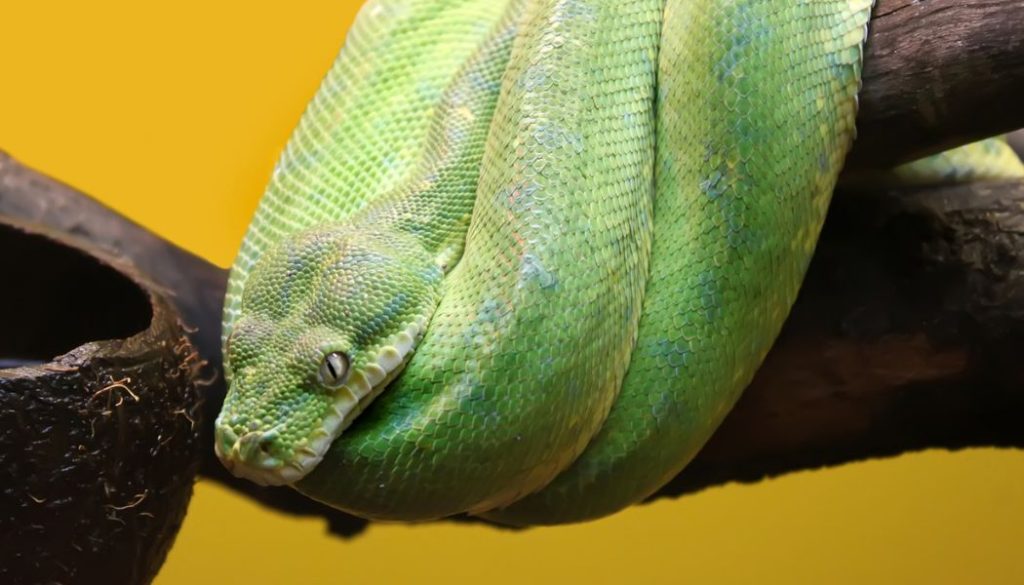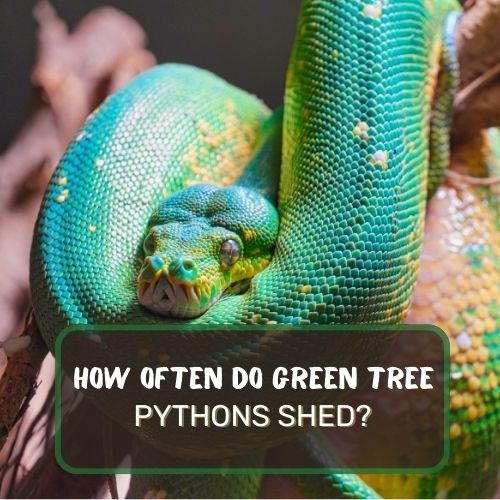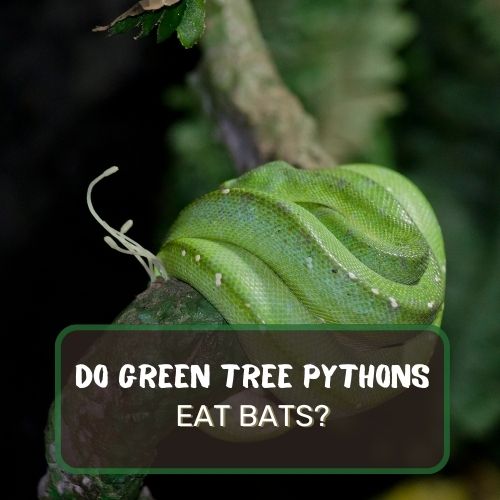Get ready for a rollercoaster of a read as we delve into the captivating world of green tree pythons and chameleons. Ever wondered if these two exotic creatures could cross paths, or better yet, if one could end up as dinner for the other?
No, green tree pythons don’t typically eat chameleons. These two reptiles are native to different parts of the world, with green tree pythons found in Australia and Papua New Guinea, while chameleons are mainly from places like Madagascar and the Middle East.
Their habitats don’t overlap, making it unlikely for them to cross paths. Even in a hypothetical encounter, chameleons have several survival tactics, like camouflage, that could give them a fighting chance.
So, while it’s a tantalizing question, the reality is that these two critters don’t mix on the food chain.
We’re diving deep into their natural diets, habitats, and even survival tactics to unravel this reptilian mystery.
Plus, if you’re a reptile keeper, we’ve got some important tips for you. Hang onto your seats; it’s going to be a wild ride!

Table of Contents
Diets of Green Tree Pythons
Oh, the green tree python! With its hypnotic green scales and coiled posture, it’s a reptile that turns heads for sure. Native to the tropical rainforests of Australia and Papua New Guinea, these beauties love the trees, hence the name.
But let’s get to the meat of the matter—what’s on the menu for these slithery tree-huggers?
In the wild, green tree pythons are primarily ambush predators. Yeah, they’re the sneaky types! They coil around tree branches, waiting patiently for prey to wander within striking distance.
When the moment is right—Bam!—they strike. So, what’s the usual fare? We’re talking small mammals, like rodents, and a variety of birds. Yes, that’s right, they’re not picky eaters!
And for those of you wondering about their hunting techniques, it’s like watching a thriller movie. They usually hang from a branch using their prehensile tail and snatch their dinner with jaw-dropping speed.
Now, rodents and birds are typical victims, but what about our colorful friends, the chameleons? The intrigue thickens!
Chameleons: The Masters of Camouflage
Ah, the chameleon—a critter that’s become synonymous with adaptability and deception. Masters of disguise, chameleons can change their skin color in the blink of an eye.
They do it for all sorts of reasons: to communicate, to regulate their body temperature, and, of course, to avoid becoming someone else’s lunch.
Hailing from the warmer regions of the world like Madagascar, southern Europe, and the Middle East, these creatures are usually found in trees, shrubs, or sometimes scampering around in open spaces.
Their diet? Mostly insects.
Yes, they’re the bug zappers of the reptile world! They use their incredibly long, sticky tongues to catch insects mid-air. Trust me, it’s like watching a live-action nature documentary!
So, with their respective habitats, could a chameleon and a green tree python ever cross paths? Well, not likely. Their native territories don’t overlap. Even if they did meet, chameleons have some slick defense mechanisms.
Their color-changing ability might not entirely deter a hungry python, but it could give them a few precious moments to scuttle away.
To bring this captivating topic full circle, the likelihood of a green tree python munching on a chameleon is slim to none. It’s not that they wouldn’t, but geography and fate seem to have decided that their paths shall rarely, if ever, cross. How’s that for a plot twist?
Could Green Tree Pythons and Chameleons Ever Cross Paths?
We’ve established the stomping grounds of both the green tree pythons and chameleons.
While green tree pythons are lounging around in the rainforests of Australia and Papua New Guinea, chameleons are busy doing their chameleon-y things in places like Madagascar, southern Europe, and the Middle East.
Sounds like they’re worlds apart, doesn’t it? Well, that’s because they are.
If this was a Hollywood movie, we’d write a scene where they meet, perhaps in some international reptile summit. But in reality, it’s unlikely. Their native habitats just don’t overlap, folks! No passport, no meeting. Simple as that.
Yet, let’s indulge in some hypotheticals. What if, somehow, they were placed in the same environment? Would green tree pythons be feasting on chameleons? Before you jump to conclusions, let’s examine the survival tactics of our elusive chameleons.
Do Chameleons Stand a Chance? Survival Tactics
Alright, so we’ve put our green tree python and chameleon in the same imaginary arena. A clash of the titans, if you will. So what could possibly happen?
Firstly, chameleons are no dummies. They’ve got the camo game down to an art. From light greens to dark browns, they can blend in with their surroundings like they were born to do it.
And actually, they were! This is their first line of defense, and they’re darn good at it.
Secondly, chameleons are agile and quick when they need to be. While they’re not going to win any Olympic sprinting medals, they can move surprisingly fast through shrubs and trees, making use of their unique foot structure to grip branches securely.
Now, what about those pythons? Remember, green tree pythons are ambush predators. They lie in wait, but they’re not built for a high-speed chase.
If a chameleon detects danger, its speed and agility could potentially be enough to get it out of the python’s striking range.
Also, chameleons are generally small compared to the green tree python’s usual prey. It may not be worth the python’s time and energy to go after such a small, elusive, and unfamiliar snack.
In the end, if a chameleon and a green tree python ever did cross paths, it seems like the chameleon could have a fighting chance. Its defense mechanisms, agility, and size make it a less-than-ideal target for our python friend.
What It Means for Reptile Keepers: The Domestic Angle
Okay, so you’re a reptile enthusiast, and you’re thinking, “Hey, why not bring both of these extraordinary creatures into my life?” Slow down, tiger! Mixing different species in captivity is a complex issue that requires a lot of careful planning.
So let’s cut to the chase: Should you keep a green tree python and a chameleon in the same enclosure? The short answer is a resounding no.
Green tree pythons and chameleons have drastically different environmental needs. Pythons like it humid and warm, while chameleons prefer well-ventilated areas with temperature gradients.
And remember, green tree pythons are predators by nature, so the stress level for your chameleon would be through the roof! Stress can lead to health problems, and let’s be honest, we want our reptile buddies to thrive, not just survive.
Plus, it’s not just about the python potentially eyeing the chameleon as a snack. It’s about the psychological stress, the difference in dietary needs, and, honestly, the ethics of keeping predator and prey in the same confined space.
So, for the sake of both animals’ wellbeing, it’s best to admire this hypothetical pairing from afar.
Conclusion
You’ve just journeyed through the fascinating worlds of green tree pythons and chameleons, exploring their diets, habitats, and even some hypothetical showdowns.
While these two mesmerizing creatures are unlikely to cross paths in the wild, it’s intriguing to ponder what could happen if they did.
If you’re a reptile keeper, you now know the importance of respecting each animal’s unique needs and keeping them in separate enclosures.
As you continue to explore the wonders of the animal kingdom, let your curiosity guide you.
There’s always something new to learn, and who knows what captivating discoveries await you next!
FAQ
So you’ve got questions, and who can blame you? This topic is chock-full of intrigue. Let’s get you some answers.
What does the green tree python eat?
In the wild, these pythons usually feast on small mammals like rodents and a variety of birds. They’re ambush predators who love a good surprise attack from their arboreal perch.
Do green tree pythons eat toucans?
Although green tree pythons eat birds, toucans are generally not on the menu. They don’t share the same habitat, and toucans are a bit large and equipped with that massive beak. Not exactly an easy meal!
Do green tree pythons eat sloths?
This one’s a little out there. Sloths are not part of the green tree python’s diet. They’re too large, and also, sloths are primarily found in South and Central America, which is not where these pythons call home.




0 Comments